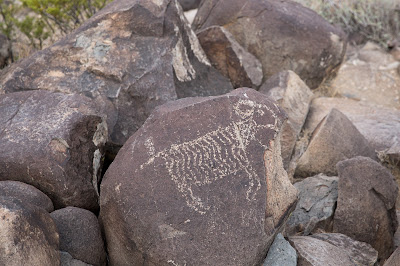Our first day exploring New Mexico was pretty darn phenomenal, but day two turned out to be nearly as much fun, if not better!
After a good's night sleep and hearty breakfast, we headed north to Three Rivers Petroglyph Site. This place was amazing! A Native American tribe called the Jornada Mogollon (with no known modern descendants) carved petroglyphs on rocks over 600 years ago. More than 20,000 petroglyphs have been identified! Many show animals, faces and symbols, but their meanings are not fully known.
The Three River Petroglyph Site is managed by the Bureau of Land Management, and we got in free with our brand new National Parks Pass. One of the very best things about this site was that we were invited and encouraged to wander off trail and climb the rocks. The boys loved clambering over the rocks to explore.
It was an overcast day, which was just perfect for adventuring outside.
Gene did some sketching.
The full trail (out and back) was 2 1/2 miles and of course we decided to hike the whole thing.
This rock was the payoff at the end of the trail -- it was huge and perched on the edge of a cliff.
What a phenomenal place -- uncrowded and definitely worth a visit.
Gene took a couple of panoramic shots -- click on them to enlarge!
After a quick stop for lunch, we drove on to Valley of Fires Recreation Area outside of Carrizozo. We got in free again with our National Parks Pass.
The Valley of Fires Recreation Area is located next to the Malpais Lava Flow. Some 5000 years ago, Little Black Peak erupted and lava flowed 44 miles into the Tularosa Basin. The molten rock spread quickly and is 4-6 miles wide, 160 feet thick and covers 125 square miles!
The lava flow is teeming with life -- and like the gypsum sand dunes we visited, the plants and animals have adapted to life in this very different environment.
Once again, we were encouraged to venture off the path and explore the lava flow.
400 year old juniper tree
Valley of Fires was definitely worth a visit!
Next up, we headed east to Smokey Bear Historical Park.
In 1944, Smokey Bear was created by the US Forestry Service to promote fire prevention. In 1950, a badly burned black bear cub was found in the aftermath of a horrible fire in the Capitan Mountains. The cub recovered and became the living symbol of fire prevention, living out his life in the National Zoo in Washington, D.C. When Smokey Bear died in 1976, his remains were flown back to the town of Capitan, New Mexico. Smokey Bear Historical Park focuses on the history of fire prevention and the two-acre garden behind showcases the ecological diversity of the state.
Playground behind Smokey Bear Historical Park



















































No comments:
Post a Comment